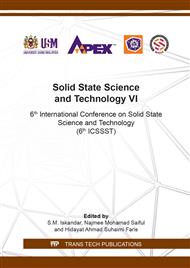[1]
Y. Nanishi, Y. Saito, T. Yamaguchi, RF-molecular beam epitaxy growth and properties of InN and related alloys, Jpn. J. Appl. Phys. 42 (2003) 2549–2559.
DOI: 10.1143/jjap.42.2549
Google Scholar
[2]
Z.Y. Xie, R. Zhang, X. Q. Xiu, B. Liu, L. Li, P. Han, S.L. Gu, Y. Shi, Y.D. Zheng, Growth and characterization of InN thin films on sapphire by MOCVD, Chin. Phys. Lett. 24 (2007) 1004–1006.
Google Scholar
[3]
E. Monroy, F. Omnes and F. Calle, Wide bandgap semiconductor ultaviolet photodetectors, Semicond. Sci. Technol., 18 (2003) 33-51.
DOI: 10.1088/0268-1242/18/4/201
Google Scholar
[4]
A. G. Bhuiyan, A. Hashimoto, and A. Yamamoto, Indium nitride (InN): A review on growth, characterization, and properties, J. Appl. Phys. 94 (2003) 2779–2808.
DOI: 10.1063/1.1595135
Google Scholar
[5]
J. B McChesney, P. M. Bridenbaugh, P.B. O'Connor, Thermal stability of indium nitride elevated temperature andnitrogen pressure, Mater. Res. Bull. 5 (1970) 783-792.
Google Scholar
[6]
X.H. Ji, S. P. Lau, H.Y. Yang, Q. Y. Zhang, Structural and optical properties of wrzite InN Grown on Si(111),, Thin Solid Films 515 (2007) 4619-4623.
DOI: 10.1016/j.tsf.2006.11.046
Google Scholar
[7]
S. Y. Kuo, W.C. Chen, J. F. Yang, C. N. Hsiao, F. I. Lai, Morphology evolution of nano-structured InN grown by MOMBE, J. Mater. Sci.: Mater. Electron. 26 (2015) 4285-4289.
DOI: 10.1007/s10854-015-2980-9
Google Scholar
[8]
H. Xiao, X. Wang, J. Wang, N. Zhang,H. Liu, Y. Zheng, Growth and charcterization of InN on sapphire substrate by RF-MBE, J. Cryst. Growth 276 (2005) 401-403.
DOI: 10.1016/j.jcrysgro.2004.12.001
Google Scholar
[9]
W. C. Chen, S.Y. Kuo, Study of high quality indium nitride films grown on Si (100) Substrate by RF-MOMBE with GZO and AlN buffer lyers, J. Nanometer. 2012 (2012) 853021.
DOI: 10.1155/2012/853021
Google Scholar
[10]
S. Ruffenach, M. Moret, O. Briot, and B. Gil, Recent advances in the MOVPE growth of Indium nitride, Phys. Status Solidi. 18 (2010) 9–18.
DOI: 10.1002/pssa.200982642
Google Scholar
[11]
P. Singha, P. Ruterana, M. Morales, F. Goubilleau, M.Wojdak, J.F. Carlin, M. Ilegems, D. Chateigner, Structural and optical characterization of InN layers grown by MOCVD, Superlattice Microst. 36 (2004) 537-545.
DOI: 10.1016/j.spmi.2004.10.002
Google Scholar
[12]
V. Ganesh, M. Alizadeh, A. Shuhaimi, A. Pandikumar, B.T. Goh, N.M. Huang, S.A. Rahman, Investigation of the electrochemical behavior of indium nitride thin films by plasma-assisted reactive evaporation, RSC Adv. 5 (2015) 17325–17335.
DOI: 10.1039/c4ra16258g
Google Scholar
[13]
M. Amirhoseiny, Z. Hassan, S. S. Ng, Fabrication of Heterostructure InN/photo- electrochemical Etched Silicon (110), Int. J. Electrochem. Sci., 8 (2013) 5042 – 5051.
Google Scholar
[14]
Dupont, Kapton properties, Int. Immunol. 26 (2014) 1-25.
Google Scholar
[15]
Q. Guo, N. Shingai, Y. Mitsuishi, M. Nishio, and H. Ogawa, Effects of nitrogen/argon ratio on composition and structure of InNfilms prepared by r.f.magnetron sputtering, Thin Solid Films. 1-2 (1999) 524-527.
DOI: 10.1016/s0040-6090(98)01671-x
Google Scholar
[16]
J. Li, S. Wu, and J. Kang, ZnO films deposited by RF magnetron sputtering, Proceedings of the 13th IEEE Semi- conducting and Semi-Insulating Materials Conference (SIMC '04), 9 (2004) 77–80.
DOI: 10.1109/sim.2005.1511390
Google Scholar
[17]
K. S. a Butcher, M. Wintrebert-Fouquet, P. P. T. Chen, T. L. Tansley, H. Dou, S. K. Shrestha, H. Timmers, M. Kuball, K. E. Prince, and J. E. Bradby, Nitrogen-rich indium nitride, J. Appl. Phys. 95 (2004) 6124–6128.
DOI: 10.1063/1.1711173
Google Scholar
[18]
T. Takeichi, Y. Eguchi, Y. Kaburagi, Y. Hishiyama, and M. Inagaki, Carbonization and graphitization of Kapton-type polyimide films prepared from polyamide alkyl ester, Carbon N. Y. 36 (1998) 117–122.
DOI: 10.1016/s0008-6223(97)00155-3
Google Scholar
[19]
X. Pang, L. Zhang, H.Yang, Residual stress and surface energy of sputtered TiN films Materials Engineering and Performance, 24 (2015) 1185-1191.
DOI: 10.1007/s11665-015-1393-5
Google Scholar


